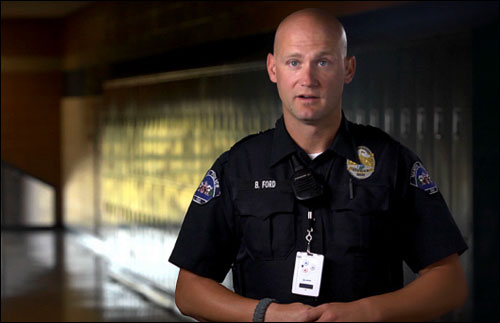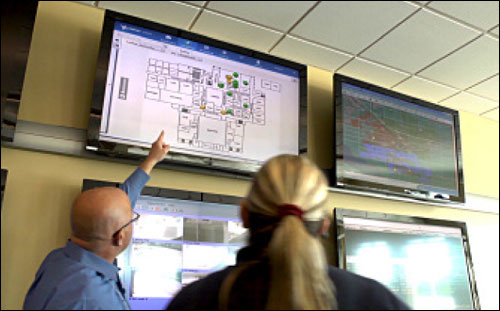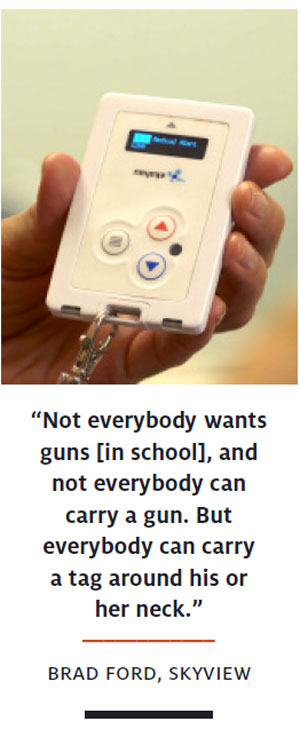Jun 18, 2014A student at Skyview High School in Nampa, Idaho, was acting unruly. His teacher suspected he might have been drinking. Faced with such a disciplinary problem in the past, she would have had to leave the classroom to call for assistance from another teacher or security. Instead, she pressed a button on a tag worn around her neck.
In minutes, four administrators, two security officers and Brad Ford, Skyview's school resource officer (a police officer charged with protecting the school) converged on the classroom. "Seven people showed up here just because the teacher needed help?" the astonished student asked.

"Absolutely!" Ford told him.
A year ago, Skyview High School, which has roughly 1,300 students, deployed an RFID safety solution from Ekahau. All 130 teachers and school administrators wear Ekahau B4 tags on lanyards, which they can use to signal for help not only with a disciplinary problem but a medical emergency, or to issue a security alert and implement a lockdown.
"Violence in schools is not going away," Ford says. "We need to change our tactics and empower teachers." One concern with standard lockdown procedures is that teachers are expected to take many steps in rapid succession. "You need to get the kids in lockdown, shut the door, turn the lights off, call 911 and tell them what's going on," he says. "It's too much, I think."
Thinking Outside the Box
The project began when Ford was discussing school safety with the school's guidance counselor, Mandy Petty, and her husband. In the wake of the 2012 shootings at Sandy Hook Elementary school in Connecticut, they wondered if there were measures they could take, beyond the usual lockdown drills, to keep students safe.
That conversation led to a lot of research. Many schools were putting panic buttons on walls or desks, but that didn't seem to be an ideal solution. What if, in an emergency, a teacher were unable to reach the button? "Let's allow [teachers] an item that gives them better access," Ford says.
When the guidance counselor's husband read about RFID tags used for personnel safety at a psychiatric hospital in California, she knew he was on to something. It stood to reason that a similar system could work in a school. In January 2013, they contacted Ekahau, provider of the hospital's tags, to find out. The timing was fortuitous. "We looked at the large deployment in California and asked ourselves where else it could be used," says Mark Norris, Ekahau's president and CEO. "Skyview reached out to us at roughly the same time." Ekahau agreed to modify its health-care solution for the education sector.
Ekahau's safety solution turned out to be a perfect—and affordable—fit for Skyview High School. The company's battery-powered B4 tags are designed to work on any Wi-Fi network. Skyview, like many schools, has a robust Wi-Fi network, so there was no need to install a system of fixed readers or antennas. The company placed several of its wire-free infrared location beacons in the school's classrooms to help ensure the system's accuracy at locating tags.

At a community meeting, Ford advocated for the solution, and an anonymous donor funded the Skyview deployment with a grant of approximately $32,000, which covered the cost of the tags, beacons and software. Norris says that, in general, a price of $30 to $40 per student is typical for a school. (Prices are per student, in keeping with usual pricing practices for schools, though the tags are issued to the teachers.)
Deploying the system at Skyview took only three days, beginning on April 12, 2013. Ekahau reps spent the first day doing a site survey and distributing the tags. They also set up the Vision software, which lets Ford and the school administrators send messages to the tags' LED screens. In addition, Vision displays a map of the school by floor, showing the location of each tag in real time, so administrators can watch as tag wearers move through the school. The school has also given the local police, fire department, emergency medical service and emergency dispatch access to the software via Web browser.
On the second day, Ekahau pros taught Skyview teachers how to use the tags, and trained Ford and administrators to use the software. On day three, the Ekahau team stayed onsite to answer lingering questions and make sure things were going as planned. They completed testing by April 30, and got needed adjustments under way.
Managing the Messages
The Ekahau tags function as two-way communication devices. A wearer can use a tag by pressing a red or blue button, or pulling down on the tag, which releases a tab at the top. Ekahau customized the functions for Skyview. A press of the red button signals a disciplinary problem and summons Ford, the school administrators and the security team. A press of the blue button signals a medical emergency—200 Skyview students have known medical conditions—and summons the school nurses, Ford and the administrators. A pull on the tag signals an emergency requiring lockdown and sends an alarm to the entire school.
Each tag also has a small LED screen in which brief text messages can be displayed. Ford or the administrators can send a message to individual teachers or the whole teaching staff, letting them know about an urgent situation and providing instructions, such as "Gather at the West Entrance." The LED screens also automatically inform those alerted to the nature and location of the emergency. If, for example, a physical education teacher pushes the blue button during class, Ford's tag will chime and alert him with a message on the LED screen that medical assistance is needed in the gymnasium.
The Wi-Fi tags, especially with the added beacons, are generally accurate at providing location information—so much so that many teachers assume they contain GPS technology. "Tags have full Wi-Fi radio two-way communication, just as a phone or laptop does," Norris says. Ekahau's technology specializes in determining location from a radio-frequency signal using probabilistic fingerprinting (which pinpoints location based on signal strength and other factors).

In a school setting, Norris adds, that level of accuracy is sufficient. "One hundred percent room-level accuracy isn't a requirement," he says. "It's more about the location of the event in the context of what it is. If you're a nurse headed to a medical event and you arrive at the room next door, you'll be able to figure out, based on noise and activity, that the event is 12 feet to the left."
Initially, the school chose to identify the wearer only by job function, such as teacher or nurse. "We didn't want teachers to feel that Big Brother was watching them," Ford says. But then teachers started requesting to have their pictures incorporated in the software when they sent a signal. "Now when they call for help, their picture pops up and I know who called," he adds.
High-school teachers, it turns out, are more prone than medical personnel to accidentally set off a tag, perhaps because health-care professionals are more accustomed to wearing delicate equipment around their necks. "We had 11 lockdown pulls the first week," Ford says.
Accidental alarms were a big concern, as they were likely to desensitize teachers and staff members who might stop taking them seriously. Even worse, employees might become reluctant to wear the tags at all.
After some discussion, Ekahau and the school arrived at a solution. Now, when a teacher pulls the tag, which signals a lockdown, the alert reaches Ford in 3.5 seconds, but the rest of the school is not alerted for 10 seconds. During those 10 seconds, the teacher can press a button on the tag to confirm the alert and have it go out immediately. Or, if the pull was accidental, the teacher can push the tab back in, canceling the alert. The red and blue discipline and medical emergency buttons must now be held down for 3 seconds before an alarm goes out. Since these adjustments, the number of accidental alarms has decreased significantly.
Ford has discovered the tags' messaging feature can be useful even in non-emergencies. As teachers were getting used to the program, Ford sent a nightly reminder to the tags' LED screens reminding the wearers to charge the devices. The tags are charged in rack chargers at the school, and each wearer's name is written on his or her tag to avoid mix-ups.
Another time, Ford needed to talk to a teacher but his calls went unanswered because the teacher was in a noisy area and couldn't hear his phone. So Ford sent a message to the teacher's tag and knew it had been received when he saw that tag, via the software, moving through the school toward his office.
Calculating ROI
Skyview is pleased with the safety solution and hopes other schools consider it. "Not everybody wants guns [in school], and not everybody can carry a gun," Ford says. "But everybody can carry a tag around his or her neck."
Since the Skyview High School rollout, nine more U.S. school districts have begun using the tags, Norris reports, in some cases at multiple schools. Further improvements for school use are under consideration, he adds. Some teachers have suggested that the blue (medical emergency) button carry a cross symbol, and the red (discipline emergency) button sport some sort of security symbol.
Ekahau may also make cosmetic changes to the tag. "The buttons and colors are laminated, and we're considering laminated fronts as well," Norris says. That way, the tags could sport the school colors or mascot.
Meantime, at Skyview, there have been many drills but fortunately no real-life lockdowns, although the tags have been used many times for disciplinary and medical emergencies. For Kellie Hannum, a language arts teacher, having the tags means feeling safer. "I've been teaching for 16 years and have always felt isolated," she says. "Communication has been our biggest hurdle. We're using Wi-Fi technology to reduce that isolation."
Just knowing that teachers can summon security at any moment seems to act as a deterrent, Hannum adds. "The kids know it's location-enabled, and the fact that we're all connected is very much in their minds," she says. "When we're out in the hallways, I've noticed far less behavior that would be questionable because we have a way to get other support staff there quickly if something were to happen. It's one more thing for them to think through before they take action."
Students feel safer as well, Hannum adds. "I deal with the older kids and, much as they may have a tough exterior, they see things in the news and they worry about their own safety," she says. "It has done wonders for them, knowing that at the push of a button or a pull of the device I can get help, and let other people know there are things going on that shouldn't be."
Another huge advantage is that when emergency personnel show up at the school in response to a call, they don't have to wonder where to go. Dispatch personnel have access to the same Vision interface Ford has, so they can see who called for help, and the location and nature of the emergency.
"Multiple times, the fire department would arrive and ask me, 'What have we got?'" Ford says. "I would have no idea because a teacher called the nurse and the nurse called 911 directly." With the Ekahau system in place, Ford is alerted to the location and nature of an emergency before assistance arrives, and dispatchers also have access to the Vision interface so they can see for themselves.
Giving emergency responders a better view into what's going on can make all the difference, Ford adds. "Unfortunately, we take our research from things that have happened. In Columbine, it took responders three hours to move through the building, and we lost a teacher [he bled to death awaiting help while responders made sure the building was secure]. If we can stop an incident, and get people where they need to be faster, and so save more lives, the system pays for itself."
